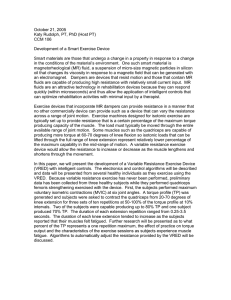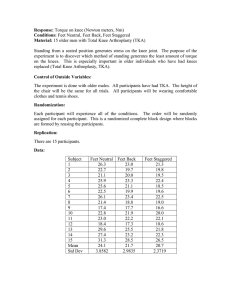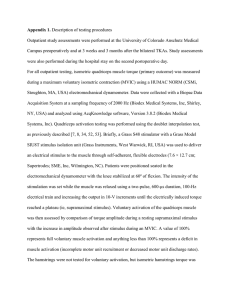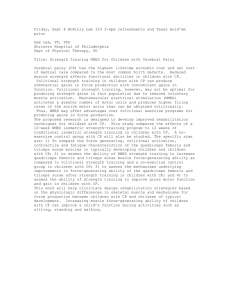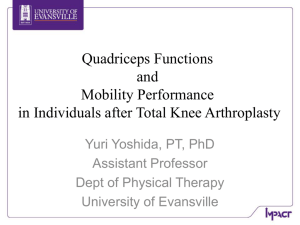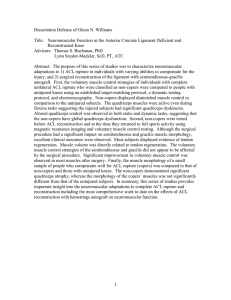[
advertisement
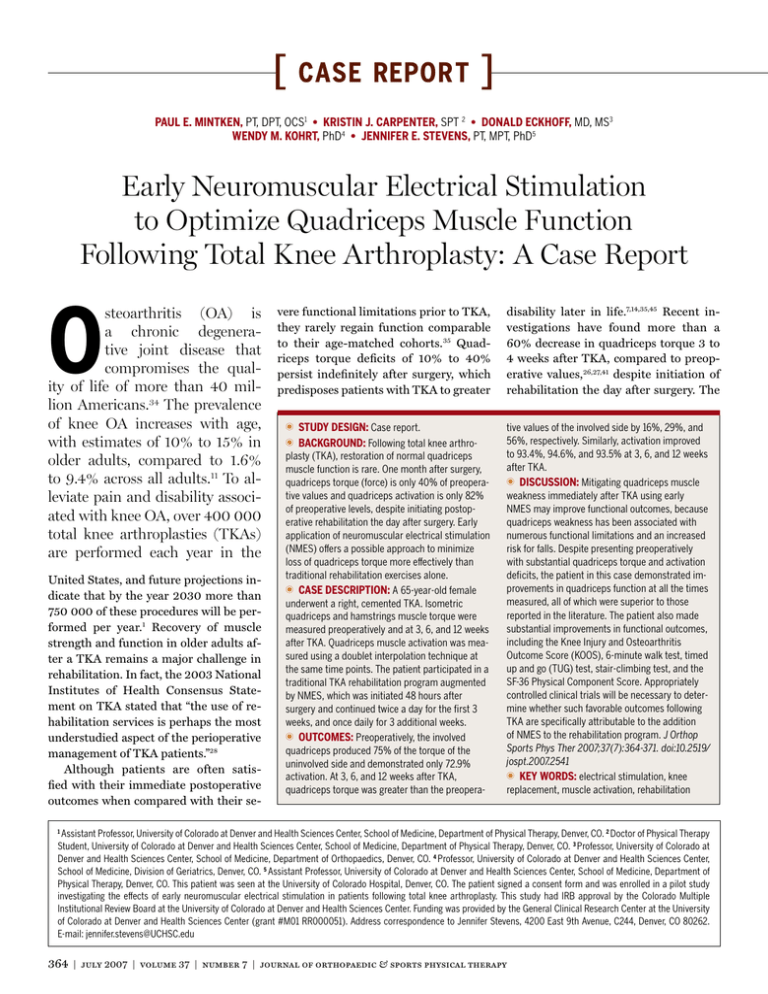
[ case report ] Paul E. Mintken, PT, DPT, OCS1 • Kristin J. CarpenteR, SPT 2 • Donald Eckhoff, MD, MS3 Wendy M. Kohrt, PhD4 • Jennifer E. Stevens, PT, MPT, PhD5 Early Neuromuscular Electrical Stimulation to Optimize Quadriceps Muscle Function Following Total Knee Arthroplasty: A Case Report O steoarthritis (OA) is a chronic degenerative joint disease that compromises the quality of life of more than 40 million Americans.34 The prevalence of knee OA increases with age, with estimates of 10% to 15% in older adults, compared to 1.6% to 9.4% across all adults.11 To alleviate pain and disability associated with knee OA, over 400 000 total knee arthroplasties (TKAs) are performed each year in the United States, and future projections indicate that by the year 2030 more than 750 000 of these procedures will be performed per year.1 Recovery of muscle strength and function in older adults after a TKA remains a major challenge in rehabilitation. In fact, the 2003 National Institutes of Health Consensus Statement on TKA stated that “the use of rehabilitation services is perhaps the most understudied aspect of the perioperative management of TKA patients.”28 Although patients are often satisfied with their immediate postoperative outcomes when compared with their se- vere functional limitations prior to TKA, they rarely regain function comparable to their age-matched cohorts. 35 Quadriceps torque deficits of 10% to 40% persist indefinitely after surgery, which predisposes patients with TKA to greater t Study Design: Case report. t Background: Following total knee arthro- plasty (TKA), restoration of normal quadriceps muscle function is rare. One month after surgery, quadriceps torque (force) is only 40% of preoperative values and quadriceps activation is only 82% of preoperative levels, despite initiating postoperative rehabilitation the day after surgery. Early application of neuromuscular electrical stimulation (NMES) offers a possible approach to minimize loss of quadriceps torque more effectively than traditional rehabilitation exercises alone. t Case Description: A 65-year-old female underwent a right, cemented TKA. Isometric quadriceps and hamstrings muscle torque were measured preoperatively and at 3, 6, and 12 weeks after TKA. Quadriceps muscle activation was measured using a doublet interpolation technique at the same time points. The patient participated in a traditional TKA rehabilitation program augmented by NMES, which was initiated 48 hours after surgery and continued twice a day for the first 3 weeks, and once daily for 3 additional weeks. t Outcomes: Preoperatively, the involved quadriceps produced 75% of the torque of the uninvolved side and demonstrated only 72.9% activation. At 3, 6, and 12 weeks after TKA, quadriceps torque was greater than the preopera- disability later in life.7,14,35,45 Recent investigations have found more than a 60% decrease in quadriceps torque 3 to 4 weeks after TKA, compared to preoperative values,26,27,41 despite initiation of rehabilitation the day after surgery. The tive values of the involved side by 16%, 29%, and 56%, respectively. Similarly, activation improved to 93.4%, 94.6%, and 93.5% at 3, 6, and 12 weeks after TKA. t Discussion: Mitigating quadriceps muscle weakness immediately after TKA using early NMES may improve functional outcomes, because quadriceps weakness has been associated with numerous functional limitations and an increased risk for falls. Despite presenting preoperatively with substantial quadriceps torque and activation deficits, the patient in this case demonstrated improvements in quadriceps function at all the times measured, all of which were superior to those reported in the literature. The patient also made substantial improvements in functional outcomes, including the Knee Injury and Osteoarthritis Outcome Score (KOOS), 6-minute walk test, timed up and go (TUG) test, stair-climbing test, and the SF-36 Physical Component Score. Appropriately controlled clinical trials will be necessary to determine whether such favorable outcomes following TKA are specifically attributable to the addition of NMES to the rehabilitation program. J Orthop Sports Phys Ther 2007;37(7):364-371. doi:10.2519/ jospt.2007.2541 t Key Words: electrical stimulation, knee replacement, muscle activation, rehabilitation Assistant Professor, University of Colorado at Denver and Health Sciences Center, School of Medicine, Department of Physical Therapy, Denver, CO. 2 Doctor of Physical Therapy Student, University of Colorado at Denver and Health Sciences Center, School of Medicine, Department of Physical Therapy, Denver, CO. 3 Professor, University of Colorado at Denver and Health Sciences Center, School of Medicine, Department of Orthopaedics, Denver, CO. 4 Professor, University of Colorado at Denver and Health Sciences Center, School of Medicine, Division of Geriatrics, Denver, CO. 5 Assistant Professor, University of Colorado at Denver and Health Sciences Center, School of Medicine, Department of Physical Therapy, Denver, CO. This patient was seen at the University of Colorado Hospital, Denver, CO. The patient signed a consent form and was enrolled in a pilot study investigating the effects of early neuromuscular electrical stimulation in patients following total knee arthroplasty. This study had IRB approval by the Colorado Multiple Institutional Review Board at the University of Colorado at Denver and Health Sciences Center. Funding was provided by the General Clinical Research Center at the University of Colorado at Denver and Health Sciences Center (grant #M01 RR000051). Address correspondence to Jennifer Stevens, 4200 East 9th Avenue, C244, Denver, CO 80262. E-mail: jennifer.stevens@UCHSC.edu 1 364 | july 2007 | volume 37 | number 7 | journal of orthopaedic & sports physical therapy vast majority of the torque deficit 4 weeks after TKA is attributable to impaired voluntary quadriceps muscle activation (inability to fully contract the quadriceps muscle) and quadriceps muscle atrophy, with muscle activation deficits accounting for twice as much of the loss of quadriceps torque as muscle atrophy.26 Muscle activation deficits can occur from impaired motor unit recruitment and/or decreases in motor unit discharge rates in joint musculature after distention or damage to the joint.33 Current rehabilitation strategies do not adequately address activation deficits nor do they minimize muscle atrophy in the first month after TKA, even when initiated the day after surgery. Therefore, better resolution of activation deficits within the first month after TKA may offer a more effective rehabilitation strategy to improve recovery of quadriceps muscle function. Patients with large muscle activation deficits have been reported to have negligible improvements in torque (force) even after intensive rehabilitation focused on traditional voluntary exercise paradigms.16 Such patients may have difficulty training their muscles at a sufficiently high intensity to promote strength gains. Neuromuscular electrical stimulation (NMES) offers an option to potentially mitigate quadriceps muscle activation deficits early after surgery and to restore quadriceps muscle function faster and more effectively.36-38,40 Stevens et al40 applied NMES to patients with bilateral TKA beginning 3 to 4 weeks after surgery and found that quadriceps muscle torque increased 311% compared to a 90% increase in patients receiving only voluntary exercises. Yet, even with NMES, quadriceps torque was still less than that of healthy older adults, suggesting that an earlier application of NMES may offer even greater promise for decreasing muscle atrophy within the first month after surgery to fully restore quadriceps muscle torque. Avramadis et al3 and Gotlin et al13 studied the early application of NMES (24-48 hours after TKA) and found improvements in walk- ing speed, effort of walking, extensor lag, and length of hospital stay, further suggesting that early NMES application has potential to more effectively restore functional performance. This case describes the results of initiating NMES treatment 48 hours following TKA, when quadriceps activation deficits are most pronounced. Mitigating the 60% loss of quadriceps torque within the first month following TKA by countering muscle activation deficits and decreasing muscle atrophy may offer a more efficient and cost-effective rehabilitation strategy than restoring quadriceps muscle torque after it has been lost.43 Therefore, the purpose of this case report is to describe the use of NMES beginning 48 hours after TKA, as an adjunct to standard rehabilitation to maximize improvements in quadriceps muscle torque and functional performance. CASE DESCRIPTION Patient T he patient was a 65-year-old female with severe right tibiofemoral OA from knee problems dating back to adolescence, who underwent a unilateral, tricompartmental, cemented TKA. Pain and degenerative changes in the left knee culminated in an arthroscopic debridement in August 2000. This greatly improved the pain and function in her left knee. In Spring 2005, she began experiencing occasional pain in her right knee. In May 2006, her right knee locked as she was ascending stairs. She continued to have severe pain in the right knee, so she returned to see her orthopedist. At that time, a decision was made to proceed with a right, tricompartmental, cemented TKA, using a medial parapatellar approach. Her past medical history included macular degeneration, asthma, which was controlled by Advair, Albuterol, and Singulair, and seasonal allergies for which she took Allegra and Flonase. She also took Celebrex for the knee pain associated with tibiofemoral OA in both of her lower extremities. She was also taking a daily regimen of supplements that included calcium, glucosamine and chondroitin sulfate, lutein, and a vitamin formula purported to improve macular degeneration. She rated her general health as very good, and stated that her health had not changed in the last year. She reported that she walked or rode a stationary bicycle 30 to 45 minutes per day, 5 days per week, prior to surgery but stated that she was limited by pain with moderate activities (eg, vacuuming) and vigorous activities (eg, running, lifting heavy objects). Examination The patient was initially seen 11 days prior to surgery for a baseline assessment. On this date she signed a consent form approved by the Colorado Multiple Institutional Review Board (COMIRB) at the University of Colorado at Denver and Health Sciences Center, completed a Medical Outcome Study 36-Item Short Form Health Survey (SF-36), and a Knee Injury and Osteoarthritis Outcome Score (KOOS). Functional examination included a timed up and go test (TUG), a 6-minute walk test, and a timed stairclimbing test (SCT). Isometric quadriceps and hamstrings torque, quadriceps activation, knee flexion and extension range of motion (ROM), and a verbal rating scale (VRS) for pain were also documented. In the VRS, the patient was asked to rate her level of perceived pain intensity on a numerical scale from 0 to 10, with 0 representing no pain and 10 representing the worst pain possible. All of these measures were also recorded at 3 weeks, 6 weeks, and 12 weeks postoperatively, with the exception of the SCT, which was not administered at week 3. Muscle Torque and Activation Testing Isometric quadriceps muscle torque and activation testing was performed using a doublet interpolation test, as described previously.4,5 The patient was seated and stabilized on an electromechanical dynamometer (Kin-Com 500H; Isokinetic International, Harrison, TN) with 60° of knee flexion. Gravitational effects journal of orthopaedic & sports physical therapy | volume 37 | number 7 | july 2007 | 365 [ were compensated for by the Kin-Com software. A practice maximal voluntary isometric contraction (MVIC) was then performed against the dynamometer’s force transducer. A Grass S48 stimulator with a Grass Model SIU8T stimulus isolation unit (Grass Instruments, West Warwick, RI) was used to deliver electrical stimuli for testing voluntary muscle activation via self-adherent, flexible electrodes (area, 7.6 × 12.7 cm). With the subject seated and the muscle relaxed, the intensity of stimulation was set using a 2-pulse, 600-µs pulse duration, 100-Hz electrical train by increasing the output in 10-V increments until the electrically induced torque reached a plateau. We termed this stimulus the supramaximal doublet in resting muscle (term b in the voluntary activation ratio formula below). Data were acquired on a personal computer using a Biopac data acquisition system at a sampling frequency of 2000 Hz, and analyzed using AcqKnowledge software, Version 3.8.2 (Biodex Medical Systems, Inc, Shirley, NY), which allowed for gravity correction. At this point, visual torque targets were set on the feedback monitor at slightly higher torques than produced during the practice MVIC trial. Voluntary activation of the quadriceps muscle was assessed using the doublet interpolation technique, where a supramaximal stimulus was applied during an MVIC and again, immediately afterwards, while the quadriceps muscle was at rest.42 The ratio of voluntary activation was quantified with the following formula: voluntary activation = [1 – (a/b)] × 100, where a is the torque produced by the superimposition of a supramaximal doublet on an MVIC and b is the torque produced by the same supramaximal stimulus in the resting muscle. A value of 100% represents full voluntary muscle activation and anything less than 100% represents incomplete motor unit recruitment or decreased motor unit discharge rates.4,5,42 Normalization of the torque from the superimposed doublet to the resting doublet allows for comparisons of quadriceps activation across case report ] individuals and lower extremities. Immediately following each MVIC, the VRS for pain was measured. Isometric hamstrings torque was measured using the same positioning, visual targets, and verbal encouragement described above, although no hamstrings muscle activation testing was performed. For both quadriceps and hamstrings measures, trials were repeated 3 times, unless maximal torque was within 10% of the previous attempt, in which case only 2 trials were performed. The involved lower extremity was tested at all time points. The uninvolved lower extremity was only tested before surgery and 3 months after surgery, using the aforementioned methods. Because of the progressive OA of the uninvolved knee, all comparisons for torque were made to the involved lower extremity. Health Status Questionnaires SF-36 Physical Component Score The health status of the patient was assessed using the Physical Component Score (PCS) of the SF-36. The SF-36 has been shown to capture improvements in 7 of its 8 domains in patients after TKA in the first 12 weeks after surgery.2 The SF- TABLE 1 36 is reliable, internally consistent, and easy to administer.8,46 Knee Injury and Osteoarthritis Outcome Score The KOOS is an extension of the Western Ontario and McMaster Universities Osteoarthritis Index (WOMAC) and was used to evaluate knee-specific impairments. The KOOS consists of 5 separately scored subscales: pain, other symptoms, activities of daily living (ADL), function in sport and recreation (Sport/Rec), and knee-related quality of life (QOL). The KOOS has been validated for patients with TKA and has been used to evaluate physical therapy outcomes.32 The KOOS is a valid, reliable, and responsive self-administered instrument that can be used for short-term and long-term follow-up of knee injury, including OA.32 Functional Performance Measures Measures of functional performance included the TUG, the SCT, 6-minute walk test, and a timed 30.5-m (100-ft) walk test. The TUG measures the time it takes a patient to rise from an arm chair (seat height, 46 cm), walk 3 m, turn, and return to sitting in the same chair without physical assistance.31 This test has excellent interrater and intrarater reliability Inpatient Rehabilitation Exercise Program Postoperative day 1 •Bedside exercises: ankle pumps, quadriceps sets, gluteal sets, hip abduction (supine), short-arc quads, straight-leg raise (if able) • Knee range of motion (ROM): heel slides • Bed mobility and transfer training (bed to/from chair) Postoperative day 2 • Exercises for active ROM, active assisted ROM, and terminal knee extension •Strengthening exercises (eg, ankle pumps, quadriceps sets, gluteal sets, heel slides, short-arc quads, straightleg raises, supine hip abduction) 1-3 sets of 10 repetitions for all strengthening exercises, twice/d •Gait training with assistive device on level surfaces and functional transfer training (eg, sit to/from stand, toilet transfers, bed mobility) Postoperative day 3-5 (or on discharge to rehabilitation unit) • Progression of ROM with active assisted exercises and manual stretching, as necessary •Progression of strengthening exercises to the patient’s tolerance, 1-3 sets of 10 repetitions for all strengthening exercises twice/d • Progression of ambulation distance and stair training (if applicable) with the least restrictive device • Progression of activities-of-daily-living training for discharge to home 366 | july 2007 | volume 37 | number 7 | journal of orthopaedic & sports physical therapy with an intraclass correlation coefficient (ICC) of 0.99, as measured in a group of 60 functionally disabled older adults (mean age, 80 years). 31 The SCT measures a higher level of function and has been shown to significantly correlate to the TUG test.15 Because this test is considered more challenging than the TUG, it minimizes the possibility of a ceiling effect. The 6-minute walk test measures the distance walked in 6 minutes. This test has been used extensively to measure endurance and has been validated as a measure of functional mobility specifically following knee arthroplasty.30 The 6-minute walk test has demonstrated TABLE 2 excellent test-retest reliability, with ICCs from 0.95 to 0.97, and a low coefficient of variation (10.4%).39 A timed 30.5-m (100-ft) walk test was chosen because criteria for inpatient hospital discharge following TKA in the United States often includes ambulating at least 30.5 m.10 Intervention Inpatient physical therapy started on postoperative day 1. The patient was treated with a defined set of core exercises for a total of 5 inpatient sessions before discharge from the hospital (Table 1). The patient also received NMES treatment twice daily for 15 minutes per ses- Outpatient Rehabilitation Exercise Program Range of motion (ROM) •Exercise bike (10-15 min), to be started with forward and backward pedaling with no resistance until enough ROM for full revolution - Progression: lower seat height to produce a stretch with each revolution • Active assisted ROM for knee flexion, sitting or supine, using other lower extremity to assist • Knee extension stretch with manual pressure (in clinic) or weights (at home) Strength •Quad sets, straight-leg raises (without knee extention lag), hip abduction (sidelying), hamstring curls (standing), sitting knee extension, terminal knee extensions from 45° to 0°, step-ups (5- to 15-cm block), wall slides to 45° knee flexion, 1-3 sets of 10 repetitions for all strengthening exercises -Criteria for progression: exercises are to be progressed (eg, weights, step height, etc) only once the patient -Progression: weights added to exercises, step-downs (5- to 15-cm block), front lunges, wall slides towards can complete the exercise and maintain control through 3 sets of 10 repetitions 90° knee flexion Pain and swelling • Ice and compression as needed Incision mobility • Soft tissue mobilization until incision moves freely over subcutaneous tissue sion to the involved quadriceps muscle beginning on postoperative day 2. She was educated during the course of her hospital stay regarding the use of a portable stimulation unit (Empi 300PV; Empi, St Paul, MN) for continued independent home use.22 The portable Empi 300PV stimulator that was used has been shown to produce comparable levels of peak torque to that produced by the VersaStim 380 clinical stimulator, which has been employed in previous NMES investigations, but is not practical for home use.20,40 The patient’s lower limb was secured by Velcro straps to an adjustable, portable stabilization device that allows for approximately 85° of hip flexion and 60° of knee flexion. Self-adherent, flexible electrodes (7.6 × 12.7 cm) were placed on the distal medial and proximal lateral portions of the patient’s anterior thigh (Figure 1). NMES from the portable electrical stimulator was applied to the patient’s resting muscle and the patient was instructed to relax during the muscle contraction. The intensity was set to the maximal intensity tolerated by the patient during each session. The stimulator was set to deliver a biphasic 50-Hz current for 15 seconds with a ramp-up time of 3 seconds and a 45-second off time (250-µs pulse duration). A total of 15 repetitions were performed during each session, twice a day. After hospital discharge, the patient received 7 sessions of outpatient physical therapy, 6 of which had a pool therapy component. Overall, she had 16 physi- Functional activities •Ambulation training with assistive device, as appropriate, with emphasis on heel strike, push-off at toe-off, and normal knee joint excursions •Emphasis on heel strike, push-off at toe-off, and normal knee joint excursions when able to walk without assistive device • Stair ascending and descending step over step when patient has sufficient concentric/eccentric strength Cardiovascular exercise •5 minutes of upper body ergometer (UBE) until able to pedal full revolutions on exercise bicycle, then exercise bicycle -Progression: duration of exercise progressed up to 10-15 min as patient improves endurance; increase resistance as tolerated Monitoring vital signs • Blood pressure and heart rate monitored at initial evaluation and as appropriate FIGURE 1. Electrode placement for neuromuscular electrical stimulation (actual application of neuromuscular electrical stimulation was done in 60° of knee flexion). journal of orthopaedic & sports physical therapy | volume 37 | number 7 | july 2007 | 367 [ OUTCOMES T hree weeks after surgery the patient demonstrated a 16% improvement in quadriceps torque of the involved lower extremity compared to preoperative values, which improved further at 6 weeks and 12 weeks by 29% and 56% of preoperative values, respectively (Figure 2). In contrast, hamstrings torque of the involved lower extremity was 74% of preoperative values 3 weeks after surgery, and remained 23% and 16% less than preoperative values at 6 weeks and 12 weeks after surgery, respectively (Figure 2). Quadriceps activation of the involved lower extremity, as measured by the doublet interpolation technique, improved from a preoperative value of 72.9% to 93.4% at 3 weeks, 94.6% at 6 weeks, and 93.5% at 12 weeks after TKA. ] 100 100 80 80 Torque (N-m) cal therapy sessions (5 inpatient, 4 home sessions, and 7 outpatient sessions). The outpatient rehabilitation program was based on a standardized set of core exercises with specific criteria for progression (Table 2).20,41 In addition to outpatient physical therapy, the patient was given a daily home exercise program to be completed 2 times per day for the first 6 weeks after TKA. The NMES was continued, in addition to this daily exercise program, 2 times per day for the first 3 weeks, followed by once per day for the next 3 weeks using the same parameters described above. The frequency of NMES application was dropped to once daily because the intensity of application of the stimulation was higher to induce a greater overload at a lesser frequency. The patient complained of excessive quadriceps fatigue with 2 sessions per day around 3 weeks after TKA. For the first 12 weeks following surgery, the patient recorded her home exercises in an exercise log. Her detailed records and accurate recall of her exercises were used to verify compliance with her home exercise program. A compliance meter on the EMPI 300PV unit was used to verify the patient’s compliance with NMES. case report 60 60 40 20 40 0 20 0 Symptoms ADL Preoperative testing Preoperative 3 wk Involved quadriceps Uninvolved quadriceps 6 wk 12 wk Quadriceps activation of the uninvolved lower extremity was 97.9% preoperatively and 98.7% postoperatively. At 12 weeks, the patient also demonstrated improvements over preoperative values on the SF36 Physical Component Score (PCS), the 6-minute walk test, the TUG, the timed 30.5-m walk test, and the SCT. Results of the SF-36 questionnaire and the functional outcome measures are reported in Table 3. The subject also made impressive improvements on the KOOS, specifically the ADL subscale and the function subscale, which is equivalent to the WOMAC function subscale.32 The results of the KOOS are reported in Figure 3. The intensity of the EMPI 300PV stimulator was consistently set at the maximum tolerated dose by the patient, which translated to a palpable, easily visible contraction of the quadriceps at 48 hours after surgery. At 6 weeks, the torque produced during NMES was measured while the patient was seated on the KinCom and found to translate to 35% of her maximal isometric quadriceps torque. DISCUSSION his case report provides the results following early NMES application to the quadriceps after a unilateral TKA in a patient who presented with significant impairments in quadriceps function prior to surgery. Preoperatively, the patient’s involved quadriceps produced 75% of the torque of the uninvolved leg (which also had significant Sports QOL 3 mo FIGURE 3. Results of Knee Injury and Osteoarthritis Outcome Score (KOOS). Subscale scores are on a 0-to-100 scale, with 0 representing extreme knee problems and 100 representing no knee problems. Abbreviations: ADL, activities of daily living subscale; QOL, quality of life subscale. Involved hamstrings Uninvolved hamstrings FIGURE 2. Isometric muscle torque (Nm) at 60° knee flexion. Abbreviations: ham, hamstrings; Inv, involved; quad, quadriceps; uninv, uninvolved. T Pain degenerative changes) and demonstrated a 19.3% deficit in muscle activation, which is consistent with previous reports for patients prior to TKA.6,24,25 The patient made substantial improvements in both quadriceps torque and activation in the first 3 weeks following surgery, a time frame that has typically been associated with a decrease in quadriceps torque production and activation, despite conventional rehabilitation therapy.21,26,27 Several authors have reported a 60% decrease in quadriceps muscle torque 3 to 4 weeks after TKA, despite initiating postoperative rehabilitation within 24 hours after surgery.26,27,41 Mizner et al26 reported that activation deficits accounted for twice as much of the loss of torque as muscle atrophy. In this case, a 16% improvement in quadriceps torque less than 1 month after TKA, compared to the 60% drop in quadriceps torque reported in the literature,26,27,41 suggests that adding NMES to traditional rehabilitation has the potential to counter muscle activation deficits and to restore quadriceps muscle function faster than traditional rehabilitation alone. Throughout the follow-up, quadriceps torque and activation continued to improve to levels superior to any average changes reported in the literature. Mizner et al24 studied 40 patients following unilateral TKA and reported that the torque of the involved quadriceps was 16% lower than preoperative values at 12 weeks, even though the subjects attended 6 weeks of outpatient physical therapy. We believe that our findings are 368 | july 2007 | volume 37 | number 7 | journal of orthopaedic & sports physical therapy TABLE 3 SF-36 and Functional Outcome Measures Test PeriodSF-36TUG (s) 6-min Walk Test (m) 30.5-m Walk Test (s)SCT (s) Preoperative 36.4 8.2 483.4 21.5 18.0* 3 wk 28.9 11.2 433.4 25.0 Not tested 6 wk 47.2 8.6 524.3 22.1 18.0 12 wk 45.5 7.9 518.1 20.5 13.0 Abbreviations: SCT, Stair Climbing Test; SF-36, Medical Outcome Study 36-Item Short Form Health Survey (scores range from 0 to 100, with higher scores representing better health); TUG, timed get up and go test. * Used handrail during test. noteworthy because it has been reported that quadriceps weakness may persist indefinitely after TKA, which may lead to permanent functional limitations and greater disability later in life.6,7,14,35,45 Resolving activation deficits early after TKA using NMES may offer a promising rehabilitation strategy to ensure a more complete functional recovery by attenuating muscle atrophy through improved use of the quadriceps. Of additional interest was the decline in hamstring torque postoperatively. By 12 weeks, hamstring torque still had not returned completely to preoperative levels, while quadriceps torque surpassed preoperative levels of both the involved and the uninvolved legs. The gains in quadriceps muscle function, but not hamstrings, suggest that the quadriceps improvements were mediated by the NMES rather than the patient’s overall lower extremity exercise program, which focused on increasing torque in both muscle groups. The subject in this case had similar scores on the SF-36 (PCS), TUG, and SCT to the 40 subjects reported by Mizner et al25 preoperatively. Three months after TKA her scores on the same functional outcome measures (SF-36, TUG, and SCT) were similar to the scores reported by Mizner et al for his patients 1 year after TKA. Additionally, the subject in this case outperformed average gains reported in the literature for patients following TKA in the 6-minute walk, the TUG, SF-36 (PCS), and the KOOS ADL and Quality of Life Subscales at times out to 1 year.17,29,30,32 Although the underlying muscular and neural mechanisms responsible for improved muscle performance with NMES are not fully understood, several theories have emerged that may help to explain the improvements in muscle function with NMES. One theory centers around recent evidence that NMES may exert its influence on functional measures of motor performance via peripheral afferent inputs that alter motor cortex excitability.44 Stimulation of peripheral afferent nerves has been shown to induce prolonged changes in the excitability of the human motor cortex.12 Another theory that may account for improved muscle function with NMES centers on the role of muscle hypertrophy. Several studies have shown that electrically elicited muscle contractions at high intensities can produce muscle hypertrophy and corresponding increases in torque production.9,23 Training programs in subjects with minimal activation deficits require training intensities of at least 50% to 60% of maximal voluntary effort to overload the muscle sufficiently to induce hypertrophy, with even higher intensities producing greater amounts of hypertrophy.18,19 We acknowledge that the NMES training intensity of this patient was only 35% of her maximal voluntary effort, which may not be sufficient to induce muscle hypertrophy. Yet because no NMES dose-response information is available for this patient population, we cannot rule out the possibility for some muscle hypertrophy. With respect to the use of NMES after TKA, increasing evidence suggests that NMES has potential to override muscle activation deficits and help re-educate the quadriceps muscle to improve function. 3,38,40 Avramidis et al3 reported a significant improvement in self-selected walking speed in patients who received NMES to the quadriceps 4 hours per day for 6 weeks, compared with controls at 6 weeks after TKA. Stevens et al40 reported that while patients treated with NMES starting 3 to 4 weeks after TKA showed substantial improvements in quadriceps torque and activation, the torque was still less than that of healthy older adults. Application of NMES earlier than 3 to 4 weeks after TKA may offer even greater potential to restore normal muscle function by overriding quadriceps muscle activation deficits earlier and minimizing muscle atrophy during the first month after surgery. Gotlin et al13 studied the effects of NMES applied within the first week after TKA and found that patients who received NMES reduced their knee extensor lag from 7.5° to 5.7°, compared with control subjects who had an increase in extensor lag from 5.3° to 8.3° in the same time frame. In addition, NMES decreased the length of hospital stay from 7.4 to 6.7 days. The results of this present case report are consistent with the aforementioned studies, suggesting that early introduction of NMES may be able to attenuate the significant loss of quadriceps torque and improve function in the first 3 weeks following TKA. CONCLUSION T his case report describes the results of initiating NMES within 48 hours after TKA surgery. The results suggest that early initiation of NMES is free of adverse (deleterious) effects and may alleviate deficits in muscle torque production and volitional recruitment of motor units. The reported rapid gains in quadriceps torque seem to exceed outcomes with traditional rehabilitation only or with delayed initiation of NMES. journal of orthopaedic & sports physical therapy | volume 37 | number 7 | july 2007 | 369 [ A controlled clinical trial is necessary to test the hypothesis that the favorable results are specifically attributed to the addition of NMES to the postoperative management following TKA. t references 1. A merican Academy of Orthopaedic Surgeons, Department of Research and Scientific Affairs. Primary total hip and total knee arthroplasty: projections to 2030. Rosemont, IL: American Academy of Orthopaedic Surgeons; 2002. 2. Arslanian C, Bond M. Computer assisted outcomes research in orthopedics: total joint replacement. J Med Syst. 1999;23:239-247. 3. Avramidis K, Strike PW, Taylor PN, Swain ID. Effectiveness of electric stimulation of the vastus medialis muscle in the rehabilitation of patients after total knee arthroplasty. Arch Phys Med Rehabil. 2003;84:1850-1853. 4. Behm D, Power K, Drinkwater E. Comparison of interpolation and central activation ratios as measures of muscle inactivation. Muscle Nerve. 2001;24:925-934. 5. Behm DG, St-Pierre DM, Perez D. Muscle inactivation: assessment of interpolated twitch technique. J Appl Physiol. 1996;81:2267-2273. 6. Berman AT, Bosacco SJ, Israelite C. Evaluation of total knee arthroplasty using isokinetic testing. Clin Orthop Relat Res. 1991:106-113. 7. Berth A, Urbach D, Awiszus F. Improvement of voluntary quadriceps muscle activation after total knee arthroplasty. Arch Phys Med Rehabil. 2002;83:1432-1436. 8. Brazier JE, Harper R, Munro J, Walters SJ, Snaith ML. Generic and condition-specific outcome measures for people with osteoarthritis of the knee. Rheumatology (Oxford). 1999;38:870-877. 9. Dudley GA, Castro MJ, Rogers S, Apple DF, Jr. A simple means of increasing muscle size after spinal cord injury: a pilot study. Eur J Appl Physiol Occup Physiol. 1999;80:394-396. 10. Enloe LJ, Shields RK, Smith K, Leo K, Miller B. Total hip and knee replacement treatment programs: a report using consensus. J Orthop Sports Phys Ther. 1996;23:3-11. 11. Felson DT. Epidemiology of Osteoarthritis, in Osteoarthritis. New York, NY: Oxford University Press; 2003. 12. Golaszewski S, Kremser C, Wagner M, Felber S, Aichner F, Dimitrijevic MM. Functional magnetic resonance imaging of the human motor cortex before and after whole-hand afferent electrical stimulation. Scand J Rehabil Med. 1999;31:165-173. 13. Gotlin RS, Hershkowitz S, Juris PM, Gonzalez EG, Scott WN, Insall JN. Electrical stimulation effect on extensor lag and length of hospital stay after total knee arthroplasty. Arch Phys Med Rehabil. 1994;75:957-959. case report ] 14. H uang CH, Cheng CK, Lee YT, Lee KS. Muscle strength after successful total knee replacement: a 6- to 13-year followup. Clin Orthop Relat Res. 1996:147-154. 15. Hughes C, Osman C, Woods AK. Relationship among performance on stair ambulation, functional reach, and timed up and go tests in older adults. Issues on Aging. 1993;21:18-22. 16. Hurley MV, Jones DW, Newham DJ. Arthrogenic quadriceps inhibition and rehabilitation of patients with extensive traumatic knee injuries. Clin Sci (Lond). 1994;86:305-310. 17. Jones CA, Voaklander DC, Suarez-Alma ME. Determinants of function after total knee arthroplasty. Phys Ther. 2003;83:696-706. 18. Kalapotharakos VI, Michalopoulou M, Godolias G, Tokmakidis SP, Malliou PV, Gourgoulis V. The effects of high- and moderate-resistance training on muscle function in the elderly. J Aging Phys Act. 2004;12:131-143. 19. Kraemer WJ, Adams K, Cafarelli E, et al. American College of Sports Medicine position stand. Progression models in resistance training for healthy adults. Med Sci Sports Exerc. 2002;34:364-380. 20. Lewek M, Stevens J, Snyder-Mackler L. The use of electrical stimulation to increase quadriceps femoris muscle force in an elderly patient following a total knee arthroplasty. Phys Ther. 2001;81:1565-1571. 21. Lorentzen JS, Petersen MM, Brot C, Madsen OR. Early changes in muscle strength after total knee arthroplasty. A 6-month follow-up of 30 knees. Acta Orthop Scand. 1999;70:176-179. 22. Lyons CL, Robb JB, Irrgang JJ, Fitzgerald GK. Differences in quadriceps femoris muscle torque when using a clinical electrical stimulator versus a portable electrical stimulator. Phys Ther. 2005;85:44-51. 23. Mahoney ET, Bickel CS, Elder C, et al. Changes in skeletal muscle size and glucose tolerance with electrically stimulated resistance training in subjects with chronic spinal cord injury. Arch Phys Med Rehabil. 2005;86:1502-1504. 24. Mizner RL, Petterson SC, Snyder-Mackler L. Quadriceps strength and the time course of functional recovery after total knee arthroplasty. J Orthop Sports Phys Ther. 2005;35:424-436. 25. Mizner RL, Petterson SC, Stevens JE, Axe MJ, Snyder-Mackler L. Preoperative quadriceps strength predicts functional ability one year after total knee arthroplasty. J Rheumatol. 2005;32:1533-1539. 26. Mizner RL, Petterson SC, Stevens JE, Vandenborne K, Snyder-Mackler L. Early quadriceps strength loss after total knee arthroplasty. The contributions of muscle atrophy and failure of voluntary muscle activation. J Bone Joint Surg Am. 2005;87:1047-1053. 27. Mizner RL, Stevens JE, Snyder-Mackler L. Voluntary activation and decreased force production of the quadriceps femoris muscle after total knee arthroplasty. Phys Ther. 2003;83:359-365. 28. National Institutes of Health. NIH Consensus 370 | july 2007 | volume 37 | number 7 | journal of orthopaedic & sports physical therapy 29. 30. 31. 32. 33. 34. 35. 36. 37. 38. 39. 40. 41. 42. Statement on Total Knee Replacement. NIH Consensus and State-of-the-Science Statements. Rockville, MD: National Institues of Health; 2003. Ouellet D, Moffet H. Locomotor deficits before and two months after knee arthroplasty. Arthritis Rheum. 2002;47:484-493. Parent E, Moffet H. Comparative responsiveness of locomotor tests and questionnaires used to follow early recovery after total knee arthroplasty. Arch Phys Med Rehabil. 2002;83:70-80. Podsiadlo D, Richardson S. The timed “Up & Go”: a test of basic functional mobility for frail elderly persons. J Am Geriatr Soc. 1991;39:142-148. Roos EM, Toksvig-Larsen S. Knee injury and Osteoarthritis Outcome Score (KOOS) - validation and comparison to the WOMAC in total knee replacement. Health Qual Life Outcomes. 2003;1:17. Saamanen AM, Tammi M, Kiviranta I, Jurvelin J, Helminen HJ. Maturation of proteoglycan matrix in articular cartilage under increased and decreased joint loading. A study in young rabbits. Connect Tissue Res. 1987;16:163-175. Sharma L, Kapoor D, Issa S. Epidemiology of osteoarthritis: an update. Curr Opin Rheumatol. 2006;18:147-156. Silva M, Shepherd EF, Jackson WO, Pratt JA, McClung CD, Schmalzried TP. Knee strength after total knee arthroplasty. J Arthroplasty. 2003;18:605-611. Snyder-Mackler L, Delitto A, Bailey SL, Stralka SW. Strength of the quadriceps femoris muscle and functional recovery after reconstruction of the anterior cruciate ligament. A prospective, randomized clinical trial of electrical stimulation. J Bone Joint Surg Am. 1995;77:1166-1173. Snyder-Mackler L, Delitto A, Stralka SW, Bailey SL. Use of electrical stimulation to enhance recovery of quadriceps femoris muscle force production in patients following anterior cruciate ligament reconstruction. Phys Ther. 1994;74:901-907. Snyder-Mackler L, Stevens JE, Mizner RL. Studio randomizzato sulla elettrostimolazione dopo artroprotesi di ginocchi [lecture]. 7° Corso Internazionale Ortopedia, Biomeccanica, Riabilitazione Sportiva. Assisi, Italy; 2003. Steffen TM, Hacker TA, Mollinger L. Age- and gender-related test performance in communitydwelling elderly people: Six-Minute Walk Test, Berg Balance Scale, Timed Up & Go Test, and gait speeds. Phys Ther. 2002;82:128-137. Stevens JE, Mizner RL, Snyder-Mackler L. Neuromuscular electrical stimulation for quadriceps muscle strengthening after bilateral total knee arthroplasty: a case series. J Orthop Sports Phys Ther. 2004;34:21-29. Stevens JE, Mizner RL, Snyder-Mackler L. Quadriceps strength and volitional activation before and after total knee arthroplasty for osteoarthritis. J Orthop Res. 2003;21:775-779. Stevens JE, Pathare NC, Tillman SM, et al. Relative contributions of muscle activation and muscle size to plantarflexor torque during rehabilitation after immobilization. J Orthop Res. 2006;24:1729-1736. 43. Stevens JE, Walter GA, Okereke E, et al. Muscle adaptations with immobilization and rehabilitation after ankle fracture. Med Sci Sports Exerc. 2004;36:1695-1701. 44. Tinazzi M, Zarattini S, Valeriani M, et al. Longlasting modulation of human motor cortex following prolonged transcutaneous electrical nerve stimulation (TENS) of forearm muscles: evidence of reciprocal inhibition and facilitation. Exp Brain Res. 2005;161:457-464. 45. W alsh M, Woodhouse LJ, Thomas SG, Finch E. Physical impairments and functional limitations: a comparison of individuals 1 year after total knee arthroplasty with control subjects. Phys Ther. 1998;78:248-258. 46. Ware JE, Jr., Kosinski M, Bayliss MS, McHorney CA, Rogers WH, Raczek A. Comparison of methods for the scoring and statistical analysis of SF-36 health profile and summary measures: summary of results from the Medical Outcomes Study. Med Care. 1995;33:AS264-279. 47. W ilk KE, Andrew JR, Bramlett KW, Alexander EJ, Arrigo CA. Current Concepts in Functional Rehabilitation Following Total Knee Arthroplasty. Sports Physical Therapy Section Home Study Course. Alexandria, VA: American Physical Therapy Association, Sports Physical Therapy Section; 1994. @ more information www.jospt.org journal of orthopaedic & sports physical therapy | volume 37 | number 7 | july 2007 | 371
